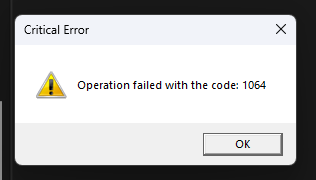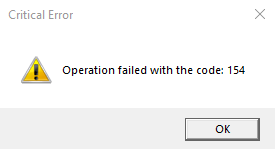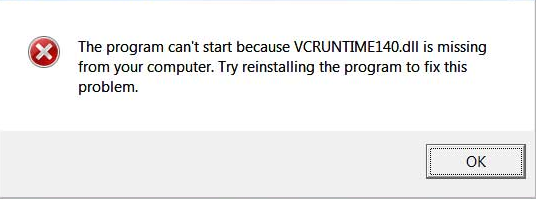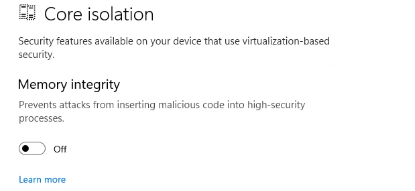This section covers critical system errors that can cause blue screens, missing DLL files, and system-level conflicts. These issues require system-level changes.
Critical Error Codes
Critical Error - Operation Failed With Code: 1064

Critical Error 1064 - Secure Boot must be disabled
This error is typically caused by Secure Boot being enabled in your system BIOS.
1
Disable Secure Boot
Access your BIOS settings and disable “Secure Boot”
2
Need Help with BIOS?
Follow Microsoft’s official guide: How to disable Secure Boot
Critical Error - Operation Failed With Code: 869/154/2310/28/34/67

Anti-cheat and security software conflict errors
Error Codes
These error codes all indicate anti-cheat or security software conflicts:
- 869, 154, 2310
- 28, 34, 67
Solution
Remove conflicting security software and disable Windows Defender completely
1
Uninstall Anti-Cheat Software
Remove the following if installed:
- Valorant’s anti-cheat (Vanguard)
- FACEIT anti-cheat
- Any third-party security software
- Third-party antivirus programs
Missing DLL Files
Missing DLL Files (MSVCP140.dll / VCRUNTIME140.dll)
MSVCP140.dll Missing

VCRUNTIME140.dll Missing

These errors indicate missing Visual C++ Redistributable files on your system.
Visual C++ Redistributable Package
File: Visual C++ Redistributable Files (All in one).zip
Password:
Contents: All Visual C++ versions in one package
Purpose: Fixes missing MSVCP140.dll and VCRUNTIME140.dll errors
Password:
proofcoreContents: All Visual C++ versions in one package
Purpose: Fixes missing MSVCP140.dll and VCRUNTIME140.dll errors
Blue Screen (BSOD) Issues
Blue Screen (BSOD) During Injection
- General Solutions
- Specific Error Codes
1
2
Check Windows Version
Install Windows 10 version 22H2 or higher if possible
3
Disable Core Isolation

Windows Security Settings - Core Isolation location
System Configuration Issues
Windows Security Settings
Core Isolation Settings
Core Isolation Settings
Location: Windows Security → Device Security → Core IsolationSettings to disable:
- Memory Integrity
- Kernel DMA Protection (if available)
Exploit Protection Settings
Exploit Protection Settings
Location: Windows Security → App & browser control → Exploit protectionSettings to disable:
- Control Flow Guard (CFG)
- Data Execution Prevention (DEP)
- Force randomization for images (Mandatory ASLR)
- Randomize memory allocations (Bottom-up ASLR)
Microsoft Vulnerable Driver Blocklist
Microsoft Vulnerable Driver Blocklist
Location: Windows Security → Device Security → Core Isolation → Microsoft Vulnerable Driver BlocklistAction: Turn off “Microsoft Vulnerable Driver Blocklist”
BIOS Settings
Secure Boot
Status: Must be DISABLED
Location: BIOS Security settings
Impact: Prevents kernel-level injection
Virtualization
Status: Disable if experiencing BSOD
Names: VT-x, AMD-V, SVM
Impact: Can conflict with injection
Advanced System Troubleshooting
Windows Update Issues
If you’re experiencing issues after recent Windows updates:1
Check Recent Updates
Go to Settings → Update & Security → Windows Update → View update history
2
Uninstall Problematic Updates
In update history, click “Uninstall updates” and remove recent updates
3
Pause Updates
Temporarily pause Windows updates for 7 days to test stability
System File Integrity
System File Checker
Command:
Purpose: Scan and repair corrupt system files
Run as: Administrator
sfc /scannowPurpose: Scan and repair corrupt system files
Run as: Administrator
DISM Tool
Command:
Purpose: Repair Windows image corruption
Run as: Administrator
DISM /Online /Cleanup-Image /RestoreHealthPurpose: Repair Windows image corruption
Run as: Administrator

